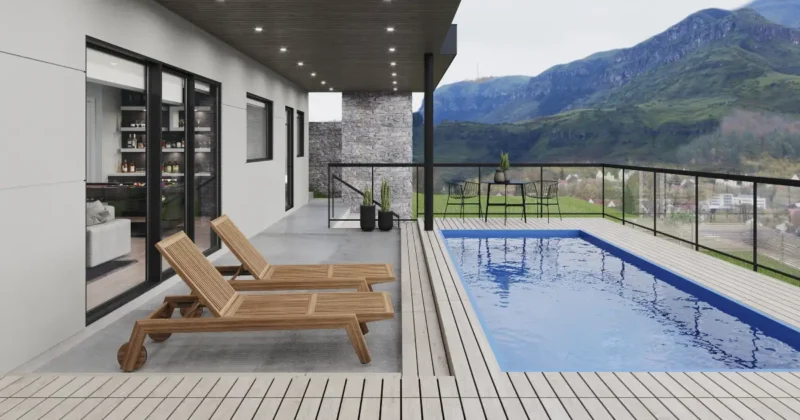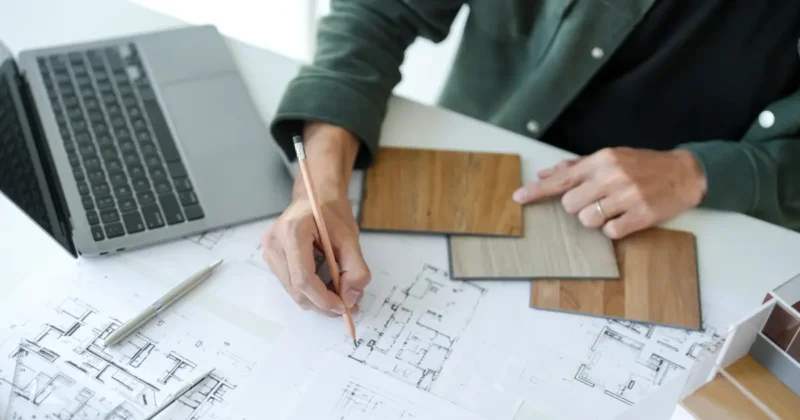Home renovation in Dubai is an exciting prospect. While it centres around lifestyle upgrades, it mainly grows property value.
Budgeting is the core of home renovation. So, start with a realistic plan. It can help you work towards your vision without much financial stress.
This guide explores everything you need to know about home renovation in Dubai and offers a few budget renovation tips.
Understanding home renovation costs in Dubai
Typical budget ranges
Dubai offers unlimited possibilities for renovations.
How much you spend depends on:
- Size of the property
- Scope of work
- Project complexity
A typical home renovation in Dubai can cost:
- Whole Apartment: Between 250,000 and 450,000 AED
- Villa: Between 400,000 and 700,000 AED
- Kitchen: Between 50,000 and 120,000 AED
- Bathroom: Between 40,000 and 90,000 AED
- Room or any small space: Between 20,000 and 50,000 AED
Prices can rise upwards if you:
- Use premium materials
- Undertake complex structural changes
Larger properties like villas often need extra work, such as:
- Landscaping
- Pool upgrades
- Additional permits
These attributes can add to the cost.

For instance:
Basic improvements to a three-bedroom villa in Dubai can cost 600,000 AED. However, if the layout is changed, the expense can rise to over 1,000,000 AED.
The cost for home renovation in Dubai depends on:
- Property size: A larger home requires more materials and a longer timeline, resulting in higher costs.
- Materials: Local products are generally cheaper. However, imported finishes add to the bill.
- Permits and approvals: They must be sought for most projects, especially within gated communities or high-rise apartments. They also add to the expense.
- Labour and timelines: Urgent projects or working with specialist professionals can increase the cost.
Knowing these cost drivers can instil greater confidence in your planning.

Common cost drivers and hidden expenses
Budgeting for visible costs, such as floors and cabinetry, is easy. However, many new homeowners may be unaware of the hidden costs.
Some cost drivers are:
- Structural vs cosmetic upgrades: The former will cost more.
- Permits and approvals: Fees depend on the kind of building or community.
- Design consultations: When hiring an expert architect or designer, your bills increase.
- Unforeseen issues: Old plumbing, aged wiring, or damaged fittings may demand urgent work at any time, which will increase the cost.
Structural upgrades include:
- Demolition of walls
- Alteration of layouts
- Updating electrical systems
Cosmetic upgrades include:
- Repainting walls
- Decluttering
- Replacing hardware
Knowing these factors can help avoid unpleasant surprises when a project progresses.
Essential budgeting ideas for homeowners in Dubai
Know your needs and priorities
Before working out a budget, define your goals. Ask yourself a few questions:
- Why are you renovating?
- Do you need something modern?
- Is it an attempt to boost functionality?
- Is the upgrade a medium to increase resale value?
You should create a vision board, take inspiration from design sites or magazines, and write down the needs and wants separately. This clarity assures that the money is spent on necessities first.
Establish a realistic and flexible budget
Calculate how much you can allocate towards home renovation. In doing so, compute every layer:
- Materials and labour
- Designer or consultant fees
- Permits and approvals
- Contingency fund
Set aside 10-20% of the budget as a buffer. While you may consciously follow budget renovation ideas, contingencies can occur anytime, so having this buffer can help prevent delays.
Set a spending parameter for each stage. So, break down the budget and allocate costs towards:
- Design and planning
- Materials and finishes
- Labour and installation
- Furnishing and decoration
The probability of overspending decreases by allocating a budget for every category or stage.
Quotation and vendor strategies
The choice of contractor or designer will largely determine your renovation journey:
- Get multiple quotes: Try to get at least three quotations. Compare them. Consider itemised breakdowns rather than totals for better clarity.
- Ask about payment conditions: Know when deposits are due. Additionally, please inquire about the structure of milestone payments.
- Ask for references: Visit some completed projects. Read client reviews on different platforms.
- Be clear about completion dates: Discuss the start and end dates, and be strict about them.
Clear communication helps avoid errors and keeps your costs in check.

Tracking and adjusting expenses
When undertaking home renovations in Dubai, discipline is paramount. For this, track every expense:
- Use a budgeting app or a spreadsheet
- Input every payment
- Track deposits and instalments
- Account for unexpected purchases
- Review totals regularly against the initial budget
- Adjust spending if you see a spike in any area
For instance:
If the premium flooring cost exceeds the estimates, try to adjust it. You can choose mid-range finishes in other parts of the home.
Ways to save costs while maintaining quality
You can save without cutting corners by making a few wise choices:
- Pick materials with solid visual impact at a lower cost. For instance, consider quartz over marble.
- Prefer vinyl floors or laminate. They mimic hardwood and still look good.
- Reuse existing items if possible. For instance, fixtures and doors can be refined.
- Do some DIY. For example, install shelves or paint feature walls.
High-impact, low-cost changes for home renovation in Dubai
Focus on key areas
Consider changes that create a significant impact:
- Renovate bathrooms and kitchens initially for maximum return.
- Switch to energy-efficient lighting fixtures.
- Apply a fresh coat of paint to boost appeal.
- Add storage solutions to maximise space.
Less expensive material options
- Peel-and-stick backsplash for kitchen and bath.
- Prefer quartz countertop over marble.
- Choose vinyl and laminate flooring.
Hot Trends for 2025
1- Sustainable living at home
Eco-consciousness is no longer a choice. It is now becoming a new standard. Today, most homeowners lean towards eco-friendly principles for their home renovations.
Some eco-friendly decisions include:
- Bamboo flooring
- Using recycled surfaces
- Energy-efficient lighting
These features are suitable for the planet. Incorporating sustainable attributes makes daily life easier and more pleasant and boosts the estate’s market value for years.
2- Multi-use rooms
Modern households seek more flexibility. Families want rooms that can serve different functions throughout the day.
For instance, a space can switch from a lounge to a dining corner, but later double as a home office.
Such a transformation requires good planning and innovative furniture. You can also make this possible with creative designs. Such homes look more practical and bigger than they are.
3- A splash of colour
Minimalism is popular, but many homeowners lean towards bold tones. Vibrant colours add to the space’s personality and make it look livelier. Bright furnishings or colourful accents can elevate the look and feel of the space. Consequently, many homeowners blend neutral tones with daring highlights. This helps create a balance between expression and simplicity.
Practical steps to maximise your renovation budget
Renovating your home needs a good amount of money. However, by making a few wise choices, you can stretch your funds and still design a home you dearly cherish.
1- Plan early
Plan well in advance. It gives you the time to:
- Conduct price comparisons
- Explore different consultants
- Wait for seasonal discounts
Stock clearances can be a goldmine for your home fittings and finishes. Reuse and recycle as much as possible. Consider polishing existing flooring or refinishing cabinetry to save more.
2- Be clear about your priorities
Identify which areas are most important. Now, allocate your budget towards them. For most households, kitchen and bathroom improvements assure the best return. However, every family has different needs. Remember, it is cost versus value. So, spending a lot on something that won’t have resale value or add to the enjoyment is unnecessary.
3- Expect the unexpected
While you cannot predict those surprises, you can still budget for them. Set aside 10% to 15% of your budget to cover unexpected expenses. This can include costs for any old systems that need urgent repair. If things go as planned, you can spend the surplus budget towards new furniture or décor.
4- Use technology
Make the most of tech. Use apps to:
- Sketch layouts
- Save measurements
- Track expenses
These apps can help reduce costly mistakes.
5- Consult people with experience
This includes adept professionals and homeowners who have recently renovated their homes. The experienced homeowners can provide dos and don’ts and help refer trustworthy contractors.
6- Ask for discounts
Lastly, when negotiating with service providers, ask for discounts. Many providers even offer package designs that bundle their services. So, do not hesitate to ask. Every little thing adds up.
Financing and payment considerations
If savings cannot cover the cost, consider financing options. In Dubai, you may find several low-interest plans or home renovation loans to help spread payments comfortably.
Always understand the repayment structure before signing. Discuss payment schedules with contractors, especially if they involve an upfront cost followed by instalments.
Contingency and avoiding cost overruns
Unforeseen costs are part of every renovation project. So, pre-plan for this by:
- Setting aside 10% to 15% of the entire budget for any surprises
- Disallowing unnecessary upgrades midway unless necessary
- Revisiting contracts to ensure they contain clear clauses regarding delays and penalties
- Discussing scope changes
Professional and community insights
Dubai has a dynamic renovation scene. So, homeowners can benefit from shared experiences:
- Watch a few tutorials on YouTube or read renovation blogs to gather creative insights
- Check out some local case studies to know real-world costing plans
- Join online forums to connect with Dubai residents who have renovated recently
Learning from others will help you refine your plan and avoid common mistakes.
Key Takeaways
Begin with a clear vision that aligns with your lifestyle objectives, and draw up a budget with 10–20% reserved for contingencies. Acquire several quotes and carefully compare their finer details before selecting one, then prioritise high-impact areas such as the kitchen and bathroom.
To balance quality and cost, pick affordable luxury materials and closely monitor expenditure using an app or spreadsheet. Avoid making scope changes mid-project, as these can disrupt budgets, and seek inspiration for innovative solutions from the Dubai community to add unique value to your renovation.
Home renovations don’t have to be overwhelming when you have the right team. Finding experienced professionals can transform your project from stressful to seamless – discover Dubai’s top-rated renovation companies to ensure your vision becomes reality.
Frequently Asked Questions (FAQs)
Budgets depend on property types and designs. An apartment remodel can cost between 40,000 and 200,000 AED. Villa projects, especially for luxury upgrades, may cost over AED 1 million. Regardless, keep aside 10-15% as a contingency fund.
Kitchen and bathroom renovations yield maximum return on investment as they increase your property value significantly
1. Start your planning early.
2. Research prices for every major item.
3. Be upfront about your budget from the start.
4. Strive for a blend of high-end features with affordable alternatives.
5. Involve your designer in planning to get a fair idea.
6. Have transparent communication with contractors and consultants.
7. Focus on permanent fixtures over replaceable décor.
8. Set aside a contingency fund for surprise or hidden costs.
9. Be flexible if the chosen material is too expensive.
10. Use apps to track your expenses and timelines.
11. Ask for discounts and negotiate with the suppliers.
12. Look for bundled packages.
Some affordable options for sustainable upgrades include:
1. Bamboo plywood
2. Faux marble
3. Reclaimed wood
4. Concrete
5. Recycled glass
Yes, you can find different financing options for undertaking home renovations. A few popular options include:
1. Unsecured personal loan
2. Secured home renovation loan
3. Renovate Now, Pay Later schemes
Conclusion
Renovating your Dubai home doesn’t have to break the bank. The idea is to plan well and stick to the budget. You can revamp your space with some practical budget renovation ideas and get good value.
Ready to begin the renovation journey? Contact Dubai-based professionals. They will create a customised plan that matches your budget and lifestyle.